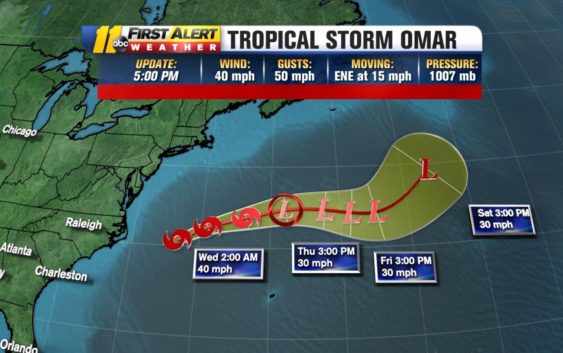- Weather Impact Alert: Brad Panovich updates severe weather risk on Sunday
- Big March storm system threatens US with tornadoes, blizzards and wildfire risk
- As city leaders consider expanding at-risk zone for wildfire damage, home builders say it could raise costs
- Is your neighborhood at high wildfire risk? | Here's how to check the city's wildfire risk map
- 'Be prepared now': Brad Panovich updates severe weather risk for Sunday
Tropical Storm Nana forms in Caribbean Sea, Tropical Storm Omar forms off North Carolina coast

The system will continue to move away from the United States over the next couple of days.
Omar formed just a few hours after a broad area of low pressure in the central Caribbean Sea formed into Tropical Storm Nana. An alert from the National Hurricane Center was sent out around noon.
Nana was moving west at 18 miles per hour and has strengthened with 50 mph winds about 120 miles southwest of Kingston, Jamaica. The system is the earliest-named “N” storm in history.
People in Jamaica, Honduras, Belize, Guatemala and the Yucatan peninsula could see heavy rain from Nana. A Tropical Storm Watch was issued for northern Honduras and the offshore Roatan islands.
The 2020 hurricane season is shaping up to be one of the most active on record. So far this season, Cristobal, Edouard, Fay, Gonzalo, Hanna, Isaias, Josephine, Kyle, Laura, and Marco all set records for being the earliest of their respective letters to ever form.
That means this season is on pace to break the record for most named storms ever. The previous record for most named storms happened in 2005 when 27 named storms formed, including 14 hurricanes.
Plus, the historical peak of hurricane season has not even arrived yet. That occurs Sept. 15.
Storm Ready 2020: Preparing in a Pandemic
Next potential storm
Preparing your hurricane kit during COVID-19
Another system is expected to move off the coast of Africa this week. Some development is possible and it passes to the south of the Cabo Verde Islands. The system currently has a 40% chance to develop.
Copyright © 2020 WTVD-TV. All Rights Reserved.